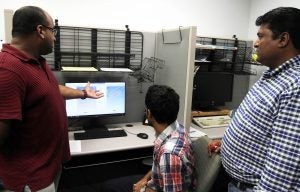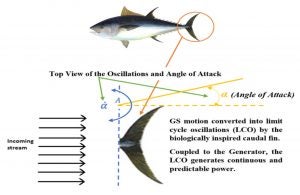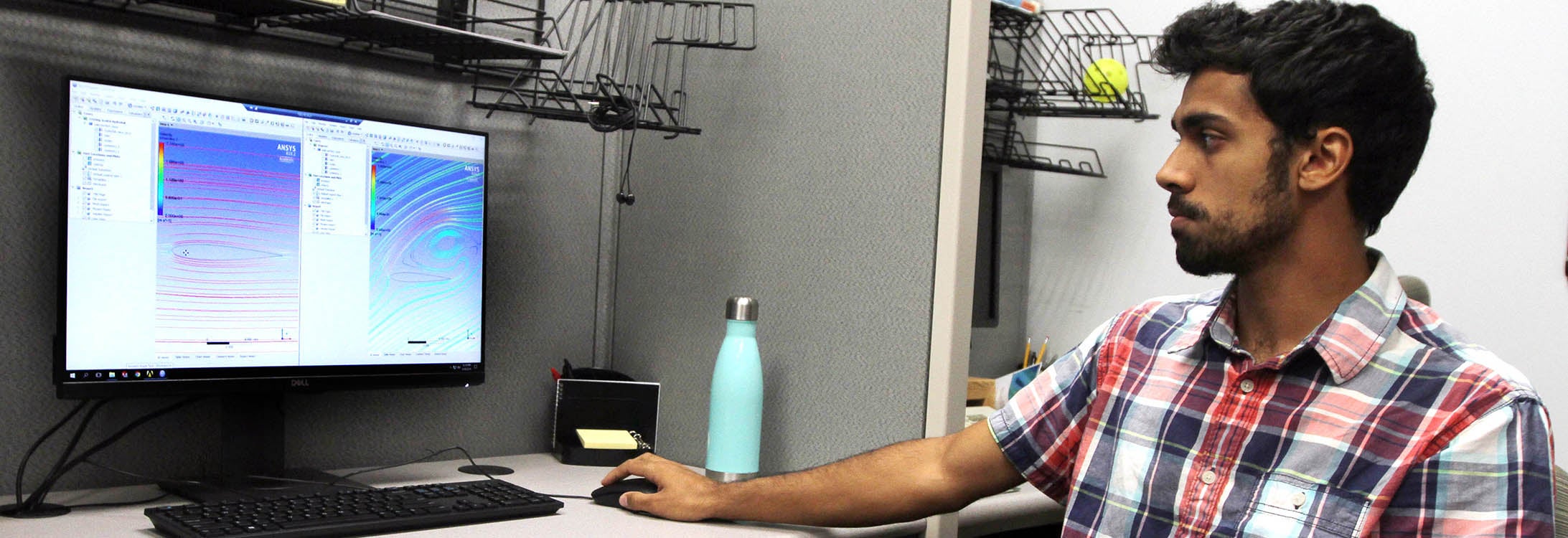WAVE OF ENERGY
ECU research team aims to extract power from the Gulf Stream
Finding inspiration in nature, two East Carolina University professors and their student researchers are hoping to put the current of the Gulf Stream to good use.
Dr. Praveen Malali, director of research for the Center for Sustainable Energy and Environmental Engineering, and Dr. Ranjeet Agarwala, assistant professor in the Department of Technology Systems, received a $13,000 seed grant from the Natural Resources and Environment cluster in the ECU Division of Research, Economic Development and Engagement. Their goal is to use the Gulf Stream — that warm current of water that flows off the East Coast — and a device they design to produce power.

Dr. Praveen Malali, left, and Dr. Ranjeet Agarwala, right, look over hydropower research simulations with student Caleb Paul. (Photo by Ken Buday)
“We have all this potential energy. It’s energy that’s there all the time, renewable in waves, the Gulf Stream, rivers or wherever,” said student researcher Caleb Paul, a senior from Greenville. “We just have to figure out the best way to design something to tap into that because it’s already there.”
They started with computer simulations of basic foils, similar to air foils or wings on an aircraft. However, the team believes the best design may be one that already exists in nature.
“Obviously, nature knows best. She’s had the longest time to do these things,” said student researcher Kelsey Kennedy, a junior from Potter’s Hill. “We can take inspiration from Mother Nature to get the most performance in trying to get as much energy as we can.”
Specifically, the group is looking at the fins of fish for the optimal design.
“What we are trying to do is place a fin in the water at a particular angle where it self-oscillates,” Agarwala said. “When it oscillates, it produces a motion that can generate energy. That’s converting that kinetic energy into electrical energy. It’s not a whole lot of power coming out of it, but it’s just enough.”
Malali said a well-designed device placed in the Gulf Stream current could be enough to supply power to weather buoys or unmanned underwater vehicles.
“There’s a tremendous push toward Underwater Autonomous Vehicles (UAVs) and one of the challenges on some of these systems is how to power them,” Malali said. “What we are doing can be tied into that because we are exploring small scale systems or harvesting systems that can be attached to an Underwater Autonomous Vehicle and using our mechanism to power the battery or charge the battery.”
Malali said a potential use of UAVs may come in helping forecast hurricanes where the device can be placed in the water in front of a storm and then steered into it.

The researchers are finding inspiration to harness energy from the Gulf Stream in nature, such as the tail fin of a fish.
“To monitor hurricanes, the best way we have now is to actually fly into one,” said Malali, adding that the flights can be expensive. “One of the things that they are exploring are these autonomous vehicles that can track wind conditions and so forth. A challenge for use of these vehicles is that they have a battery and the battery can go for only so many hours. What do you do then? Can we tap into some of these locally available power sources like the Gulf Stream or ocean waves for example to try to generate power?”
The Gulf Stream is a strong ocean current that brings warm water from the Gulf of Mexico up along the East Coast. Though its path fluctuates, the current flows about 20 miles off the coast of Cape Hatteras. The current moves at around 1.5 to 2 meters per second, which isn’t a lot compared to a car on the highway, which will cover about 27 meters per second doing 60 mph. But Malali said it’s enough and provides a renewable source of energy.
“They say the economy is going to go blue in the coming decades,” Malali said. “The way we proposed it, it was about ocean currents, but you have tidal currents and you have flowing rivers, so it can be applied to other places as well.”
And in an area such as eastern North Carolina where there is so much water and an economy that depends on it, converting the energy of the nearby Gulf Stream into power could have big consequences.
“We have a Gulf Stream that is so close to us. It has an abundance of energy,” Agarwala said. “To tap into that using any contraption we can design would be a game-changer for this area.”
Along with the students, the professors said that they have gotten plenty of support for the research, including from IT specialist Jason Gray who helped set up the high-powered computers to run the simulations, Dr. Tarek Abdel-Salam, director for the Center for Sustainable Energy and Environmental Engineering, and Burrell Montz and Alex Manda, co-directors of the ECU Natural Resources and Environment cluster.
